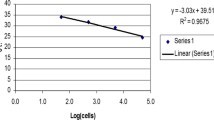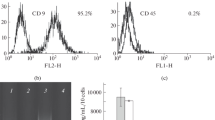Abstract
Purpose
Adipose-derived stem cells (ASCs) have promising potential in regenerative medicine and cell therapy. Our objective is to examine the biological function of the labeled stem cells following labeling with a readily available positron emission tomography (PET) tracer, 18F-fluoro-2-deoxy-D-glucose (FDG). In this work we characterize labeling efficiency through assessment of FDG uptake and retention by the ASCs and the effect of FDG on cell viability, proliferation, transdifferentiation, and cell function in vitro using rat ASCs.
Methods
Samples of 105 ASCs (from visceral fat tissue) were labeled with concentrations of FDG (1–55 Bq/cell) in 0.75 ml culture medium. Label uptake and retention, as a function of labeling time, FDG concentration, and efflux period were measured to determine optimum cell labeling conditions. Cell viability, proliferation, DNA structure damage, cell differentiation, and other cell functions were examined. Non-labeled ASC samples were used as a control for all experimental groups. Labeled ASCs were injected via tail vein in several healthy rats and initial cell biodistribution was assessed.
Results
Our results showed that FDG uptake and retention by the stem cells did not depend on FDG concentration but on labeling and efflux periods and glucose content of the labeling and efflux media. Cell viability, transdifferentiation, and cell function were not greatly affected. DNA damage due to FDG radioactivity was acute, but reversible; cells managed to repair the damage and continue with cell cycles. Over all, FDG (up to 25 Bq/cell) did not impose severe cytotoxicity in rat ASCs. Initial biodistribution of the FDG-labeled ASCs was 80% + retention in the lungs. In the delayed whole-body images (2–3 h postinjection) there was some activity distribution resembling typical FDG uptake patterns.
Conclusion
For in vivo cell tracking studies with PET tracers, the parameter of interest is the amount of radiotracer that is present in the cells being labeled and consequent biological effects. From our study we developed a labeling protocol for labeling ASCs with a readily available PET tracer, FDG. Our results indicate that ASCs can be safely labeled with FDG concentration up to 25 Bq/cell, without compromising their biological function. A labeling period of 90 min in glucose-free medium and efflux of 60 min in complete media resulted in optimum label retention, i.e., 60% + by the stem cells. The initial biodistribution of the implanted FDG-labeled stem cells can be monitored using microPET imaging.









Similar content being viewed by others
Abbreviations
- ASCs:
-
Adipose-derived stem cells
- 18F-FDG, FDG:
-
[18F]Fluoro-2-deoxy-D-glucose
- PET:
-
Positron emission tomography
References
Wollert KC, Drexler H. Clinical applications of stem cells for the heart. Circ Res 2005;96:151–63.
Rosenthal N. Prometheus’s vulture and stem-cell promise. N Engl J Med 2003;349:267–74.
Kim Y, Han H. High-glucose-induced prostaglandin E(2) and peroxisome proliferator-activated receptor delta promote mouse embryonic stem cell proliferation. Stem Cells 2008;26(3):745–55.
Baker M. Banking on the future of stem cells. Nature 2008;452(7185):263.
Forrester JS, Makkar RR, Marbán E. Long-term outcome of stem cell therapy for acute myocardial infarction: right results, wrong reasons. J Am Coll Cardiol 2009;53(24):2270–2.
Thomson M, Wall DM, Hicks RJ, Prince HM. In vivo tracking for cell therapies. Q J Nucl Med Mol Imaging 2005;49:339–48.
Zhou R, Acton PD, Ferrari VA. Imaging stem cells implanted in infarcted myocardium. J Am Coll Cardiol 2006;48(10):2094–106.
Terrovitis J, Lautamäki R, Bonios M, Fox J, Engles JM, Yu J, et al. Noninvasive quantification and optimization of acute cell retention by in vivo positron emission tomography after intramyocardial cardiac-derived stem cell delivery. J Am Coll Cardiol 2009;54(17):1619–26.
Clavo AC, Brown RS, Wahl RL. Fluorodeoxyglucose uptake in human cancer cell lines is increased by hypoxia. J Nucl Med 1995;36(9):1625–32.
Green LA, Nguyen K, Berenji B, Iyer M, Bauer E, Barrio JR, et al. A tracer kinetic model for 18F-FHBG for quantitating herpes simplex virus type 1 thymidine kinase reporter gene expression in living animals using PET. J Nucl Med 2004;45(9):1560–70.
Yaghoubi SS, Couto MA, Chen CC, Polavaram L, Cui G, Sen L, et al. Preclinical safety evaluation of 18F-FHBG: a PET reporter probe for imaging herpes simplex virus type 1 thymidine kinase (HSV1-tk) or mutant HSV1-sr39tk’s expression. J Nucl Med 2006;47(4):706–15.
Vesselle H, Grierson J, Muzi M, Pugsley JM, Schmidt RA, Rabinowitz P, et al. In vivo validation of 3′-deoxy-3′-[18F]fluorothymidine ([18F]FLT) as a proliferation imaging tracer in humans: correlation of [(18)F]FLT uptake by positron emission tomography with Ki-67 immunohistochemistry and flow cytometry in human lung tumors. Clin Cancer Res 2002;8(11):3315–23.
Bading JR, Shields AF. Imaging of cell proliferation: status and prospects. J Nucl Med 2008;49(Suppl 2):64S–80S.
Fraser J, Wulur I, Alfonso Z, Hedrick MH. Fat tissue: an underappreciated source of stem cells for biotechnology. Trends Biotechnol 2006;24(4):150–4.
Zuk PA, Zhu M, Ashjian P, De Ugarte DA, Huang JI, Mizuno H, et al. Human adipose tissue is a source of multipotent stem cells. Mol Biol Cell 2002;13(12):4279–95.
Wang L, Deng J, Wang J, Xiang B, Yang T, Gruwel M, et al. Superparamagnetic iron oxide does not affect the viability and function of adipose-derived stem cells, and superparamagnetic iron oxide-enhanced magnetic resonance imaging identifies viable cells. Magn Reson Imaging 2009;27:108–19.
Adonai N, Nguyen KN, Walsh J, Iyer M, Toyokuni T, Phelps ME, et al. Ex vivo cell labeling with 64Cu-pyruvaldehyde-bis(N4-methylthiosemicarbazone) for imaging cell trafficking in mice with positron-emission tomography. Proc Natl Acad Sci U S A 2002;99:3030–5.
Olive PL, Banáth JP. The comet assay: a method to measure DNA damage in individual cells. Nat Protoc 2006;1:23–9.
Sekiya I, Larson BL, Vuoristo JT, Cui JG, Prockop DJ. Adipogenic differentiation of human adult stem cells from bone marrow stroma (MSCs). J Bone Miner Res 2004;19:256–64.
Tai C, Chatziioannou A, Siegel S, Young J, Newport D, Goble RN, et al. Performance evaluation of the microPET P4: a PET system dedicated to animal imaging. Phys Med Biol 2001;46:1845–62.
Hall EJ. Radiobiology for the radiologist. 4th ed. Philadelphia: Lippincott; 1994.
Barbash IM, Chouraqui P, Baron J, Feinberg MS, Etzion S, Tessone A, et al. Systemic delivery of bone marrow-derived mesenchymal stem cells to the infarcted myocardium: feasibility, cell migration, and body distribution. Circulation 2003;108:863–8.
Hou D, Youssef EA, Brinton TJ, Zhang P, Rogers P, Price ET, et al. Radiolabeled cell distribution after intramyocardial, intracoronary, and interstitial retrograde coronary venous delivery: implications for current clinical trials. Circulation 2005;112(9 Suppl):I150–6.
Fueger BJ, Czernin J, Hildebrandt I, Tran C, Halpern BS, Stout D, et al. Impact of animal handling on the results of 18F-FDG PET studies in mice. J Nucl Med 2006;47:999–1006.
Acknowledgments
The authors thank the reviewers of this manuscript for their insightful comments and suggestions. This work has been supported by a Canadian Institute of Health Research (CIHR) Emerging Team Grant in Regenerative Medicine and Nanomedicine.
Conflicts of interest
None.
Author information
Authors and Affiliations
Corresponding author
Rights and permissions
About this article
Cite this article
Elhami, E., Goertzen, A.L., Xiang, B. et al. Viability and proliferation potential of adipose-derived stem cells following labeling with a positron-emitting radiotracer. Eur J Nucl Med Mol Imaging 38, 1323–1334 (2011). https://doi.org/10.1007/s00259-011-1753-9
Received:
Accepted:
Published:
Issue Date:
DOI: https://doi.org/10.1007/s00259-011-1753-9




